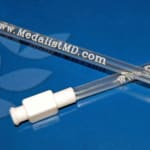 In cooperation with Teknor Apex, Medical Device Manufacturers have proven outstanding performance of tubing in cutting, hole punching, tipping, printing, and insert molding.
In cooperation with Teknor Apex, Medical Device Manufacturers have proven outstanding performance of tubing in cutting, hole punching, tipping, printing, and insert molding.Two medical contract manufacturers have demonstrated the ease and precision with which tubing made from Medalist MD-500 Series medical elastomers can be fabricated in diverse post-extrusion or “downstream” processes, enhancing the suitability of these compounds as replacements for PVC, it was announced at MD&M West by Teknor Apex Company (Booth 2233).
In prduction runs by Dunn Industries, Inc. (Booth 2941) and Pelham Plastics, Inc. (Booth 2943), Medalist-based tubing exhibited outstanding performance when subjected to in-line cutting to length and secondary operations including hole punching, tipping, printing, and insert molding, according to Elliott Pritikin, senior medical market manager for the Thermoplastic Elastomer Division of Teknor Apex. Tubing samples assembled in these processes will be on exhibit at the MD&M West booths of both contract manufacturers as well as that of Teknor Apex.

Pritikin pointed out that these successes follow two other recent demonstrations that Medalist MD-500 Series compounds provide a practical alternative to PVC in tubing: demonstration runs by American Kuhne, Inc.(booth 2330) showing the capability of Medalist MD-500 Series compounds for production in high-speed (over 800 ft./min.) tubing lines; and development by Teknor Apex of patent-pending technologies for bonding Medalist-based tubing to traditional connectors.
“Teknor Apex has recognized from the start of its development of Medalist MD-500 Series elastomers that they must perform as well as or better than PVC throughout the long sequence of processes to which tubing is subjected in the real world,” said Pritikin. “We interviewed experts throughout the medical device supply chain, including OEMs, to understand the ‘Voice of the Customer’ requirements, and these became our developmental scoreboard. During the past two years we have steadily progressed in meeting these requirements, including crystal clarity, kink resistance, clamp resilience, PVC-like haptics, extrusion at high speeds, sterilization by gamma irradiation and ETO, bonding assembly in clinical settings, and everyday handling by healthcare workers. Now we have demonstrated ease of fabrication in downstream techniques for medical tubing.”


